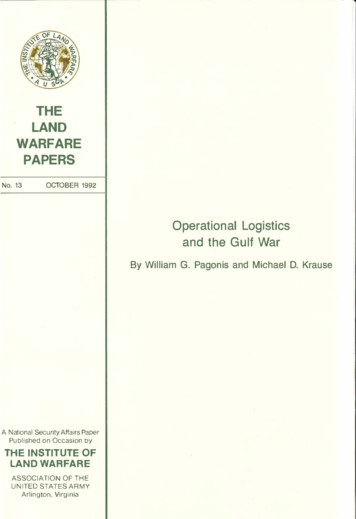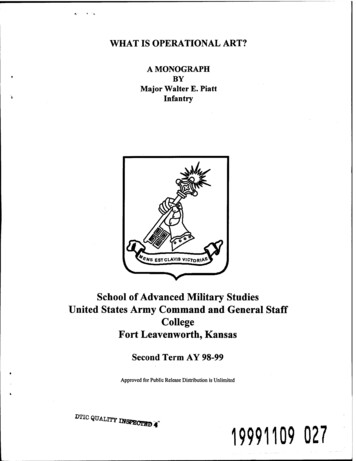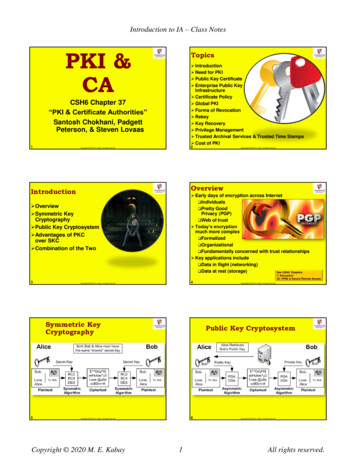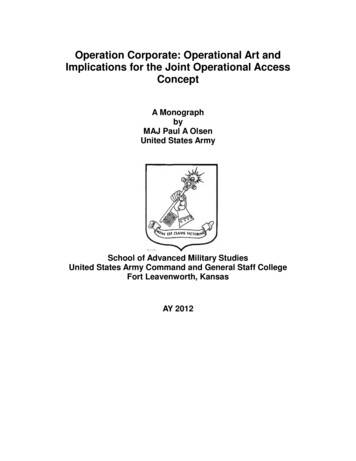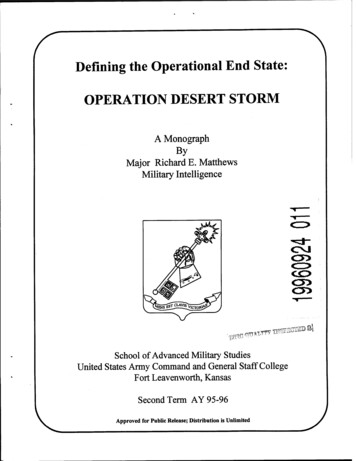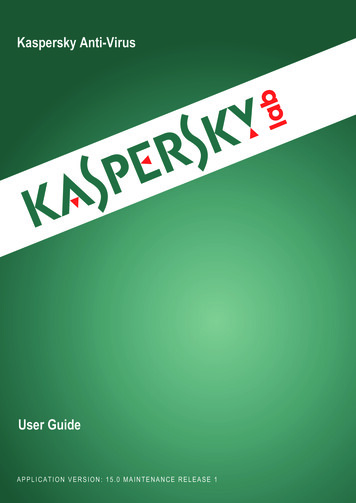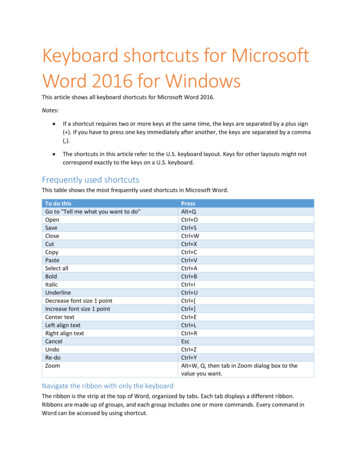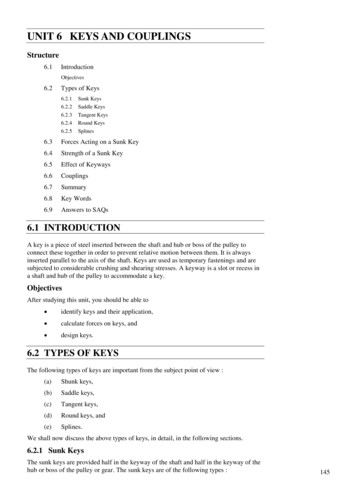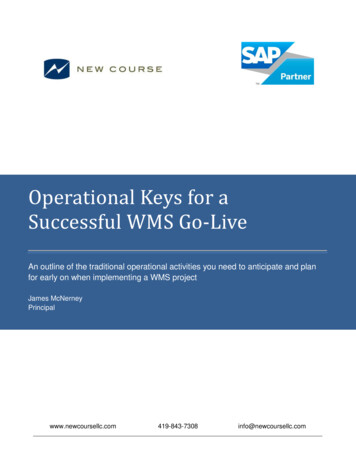
Transcription
Operational Keys for aSuccessful WMS Go-LiveAn outline of the traditional operational activities you need to anticipate and planfor early on when implementing a WMS projectJames nfo@newcoursellc.com
Operational Keys for aSuccessful WMS Go-LiveNew Course – Putting the experience of 250 WMS implementations to work foryou!“Expect the best, plan for the worst, and prepare to be surprised.” Suffice it to say, DenisWaitley, the author, must have been involved in a Warehouse Management System (WMS)implementation a time or two. Whether it’s a WMS project with SAP EWM, Oracle, JDA,Manhattan Associates, HighJump Software, Infor, or some other vendor, technical andoperational plans must be developed and properly executed in order to overcome challenges,manage the unexpected project twists and turns, and ensure success.It is important to understand that WMS software providers focus their efforts almost entirely onthe technical aspects of the implementation such as design, development, configuration,integration and installation. They leave the operational planning and execution to you, thecustomer, while offering only limited support. Planning, staffing, managing and executing theoperational work associated with a WMS implementation are key to keeping the businessrunning and continuing to satisfy customer commitments during the transition from old to new.We are not trying to minimize the importance of the technical work that WMS software vendorsperform. We realize that technical-related issues with design, development, configuration,integration and unit testing can result in delays and cost overruns. Certainly not desirable, butdefinitely not as “bone-jarring” as a failed operational cutover or poorly executed go-live, whichcan negatively impact supplier and customer relationships, cause financial hardship for theentire organization, and put your company in a hole that takes months to overcome.Our goal in this whitepaper is to outline and describe the traditional operational activities youneed to anticipate and plan for early on, rather than as an afterthought. So, whether you’reconsidering a WMS or actively involved in the deployment of one, this whitepaper is for you.WHAT ARE THE MAJOR OPERATIONAL ACTIVITIES THAT ARE NECESSARY FOR ASUCCESSFUL WMS IMPLEMENTATION?The major operational activities that you, the customer, need to plan, staff and execute tosupport a WMS project can be classified into five (5) major areas:1.2.3.4.5.Change ManagementTestingTrainingCutoverHyper Care / Go-Live Support 2014 NEW COURSE LLC1
Operational Keys for aSuccessful WMS Go-LiveChange ManagementChange management is a structured approach for handling change.Effective changemanagement requires control, communication and adoption of change so that risks areminimized and goals are met.Many WMS project charters fail to recognize the need for change management until late in theproject, or simply believe that change can be managed through training alone.WMS impacts not only the distribution center (DC), but other departments in the company, aswell as customers, carriers, and / or suppliers. Additionally, most organizations must meetinbound, outbound, labor and other key performance indicators (KPIs) during the transition, orshortly thereafter.Equally important, WMS implementations frequently impact staffing levels, roles, responsibilitiesand sometimes pay scales. Failure to deal with human resources-related changes may impactuser adoption.So how do you successfully manage change? Assign a dedicated Change Management Leadto understand, manage, control and communicate change internally and externally.Thisresource needs to be actively involved in the project from the start. The Change ManagementLead must work with the Project Manager and key decision makers from functional areas suchas Customer Service, Distribution, Manufacturing, HR, Finance, and IT in the development andcommunication of a “Smart Plan” that minimizes risks to the organization, its key tradingpartners and customers. This resource must truly understand how the organization functions,possess strong communication skills, and have the ability to make major decisions for thecompany during the WMS project.Change management, while time-consuming, is an essential element of any successful WMSimplementation and should not be overlooked.TestingEvery company plans some level of testing. What’s often missed or not fully considered duringthe development of the implementation testing plans are: The testing the organization is required to performThe effort it takes to prepare granular test scripts and / or testing mechanisms (e.g.,configuring a tool such as LoadRunner for load testing, or developing a simulation totest WMS and WCS integration)The level of documentation requiredThe resources and man-hours required to perform each level of testingTesting and validation requirements are generally driven by: The testing policies and procedures that your management expects to be satisfied 2014 NEW COURSE LLC2
Operational Keys for aSuccessful WMS Go-Live The extent of modifications that need to be made to the ERP system and otherapplications (e.g., WCS) to support the WMSThe industry your company operates withinThe type of organization (e.g., private vs. publicly-traded company)Typical types of testing that are required to be led and executed by you, the customer include: Functional TestingPre-Formal Testing (testing of the test scripts and / mechanisms prior to IntegrationTesting)Load / Volume and Response Time TestingEnd-to-End Integration TestingDry-Run TestingUser Acceptance Testing (UAT)FDA CertificationBioterrorism Act ValidationSarbanes-Oxley (SOXs) ComplianceIn order to successfully navigate and ensure all testing requirements are satisfied, a Test Leadshould be assigned and dedicated to the project. The Test Lead should be involved in thedevelopment of the implementation plan so that all testing activities and resource requirementsare properly planned.Planning and executing testing activities is a major effort that requires involvement from theentire project team, and needs to be considered prior to project kick-off.TrainingWMS software vendors provide standard training courses such as system orientation, and somewill offer, as an option, end-user training. While that’s all fine and dandy, training is a process,and final end-user training and the education of the supervisory leads should be developed andconducted by company resources. Training can also be provided by an integration firm that hasextensive experience creating and conducting training programs with the WMS software.If you elect to use an integration firm for training, the assigned resources should have strongdistribution domain expertise, and incorporate your standard operating procedures (SOPs) intothe training material and classes. However, using outside resources to lead training should notexcuse operations project members from assisting in the training. Rather, in order to helpfacilitate company-wide acceptance of the new system, the operations team needs to play anactive role.Two questions we are often asked about training are: Why do you consider training a process?Why not contract with the software vendor for end-user training? 2014 NEW COURSE LLC3
Operational Keys for aSuccessful WMS Go-LiveSo, why is training a process? Because training starts at the beginning of the project andcontinues throughout – from initial vendor software orientation and setup / configuration training,to design discussions, conference room pilots, configuration of the software by operationalproject team members, development of standard operating procedures, training programdevelopment, supervisory and end-user training, testing and startup support.Knowledgetransfer on how to configure and use the software does not happen quickly. WMS solutions arecomplex and gaining the requisite knowledge takes time and requires hands-on involvement inthe software implementation process.Why not contract with the WMS vendor for end-user training?Frankly, most softwareorganizations are not readily equipped to conduct comprehensive, extended end-user training.Also, because roles and jobs are not static in organizations, education programs need to be inplace to support changes in personnel long after the software vendor has completed their work.Finally, companies need to be self-sufficient in order to deal with the constant change that takesplace in distribution and logistics. This requires you to have a good understanding of mostaspects of the software so that you can adapt quickly to new industry, facility and customerrequirements.Will you know everything there is to know about the solution? Probably not. Will you haveenough experience to handle most day-to-day requirements that come about, includingquestions or issues that arise during go-live? Most likely, yes.CutoverCutover planning should begin early in the project. The major areas of cutover that need to beplanned and the questions that need to be considered are: Data Migration and Validationo Will all inbound and outbound orders be complete and associated transactionsposted prior to cutover?o What data does the WMS need?o Is the data from the existing system sufficient and accurate?o Can data be migrated from the current legacy system to the new WMS?o Do tools or scripts already exist that can be used to migrate the data or do weneed to develop scripts?o If data is being migrated, how long will it take to run the scripts and validate thedata?o If data cannot be migrated, how will inventory be loaded into the WMS? Howmany resources are needed to load initial inventory manually? Does that meanwe will need to do a physical inventory? What are the processes for validatingdata? Mock Cutovero What day of the week should be planned for a mock cutover?o How much time needs to be allocated for cutover – from IT and from operations?o How do we staff for the mock cutover?o How many mock cutovers need to be performed? 2014 NEW COURSE LLC4
Operational Keys for aSuccessful WMS Go-Liveo What metrics will be used to identify when the cutover plan and processes areacceptable for go-live?Go-Live Plano Who should assume responsibility for preparing the micro go-live plan?o Is there a micro plan that can be used as a starting point? If not, does thesoftware vendor have one that we can follow?o What level of detail is required for the Readiness Assessment?o What factors will drive a ‘go’ or ‘no go’ decision?o What resources are available to support the go-live effort?Cutover planning and activities are not to be taken lightly. Poor planning and decisions in thisarea can have major operational impacts.Hyper Care / Go-Live SupportMost of Hyper Care / Go-Live Support planning typically occurs during the deployment phase ofa WMS implementation. Hyper Care planning should be led by the Operations Lead withsupport from the overall Program Manager, IT Lead, Change Management Lead and theSoftware Vendor Project Manager. In most cases, it’s “all hands on deck.”Hyper Care planning should encompass each of the following elements: Key Performance Indicators (KPIs) or Metrics to measure progressCentral Help Desk Plan for logging and resolving issuesEscalation Plan so that major issues that hinder operations are prioritized and resolvedin a timely mannerOn-Site Support Plan including staffing schedule, defined roles and responsibilitiesCommunications Plan for reporting progress, issues and other important items to seniormanagement, the project team and material handling personnelIn SummaryIn any large WMS Go-Live, the key to operational success is having multiple layers of planningin place and effective tools and support teams to identify and resolve issues as they occur. Itshould be noted there will always be bumps in the road, but the important thing is to have plansin place to anticipate and minimize them as much as possible, or react and resolve them, ifneed be. Proper Change Management, Testing, Training, Cutover and Hyper Care planningand execution are the difference between operational success and failure in a large scale WMSGo-Live. 2014 NEW COURSE LLC5
Operational Keys for aSuccessful WMS Go-LiveAbout NEW COURSECreated by Jim McNerney and John Sidell, the founders of ESYNC, New Course is a leadingsupply chain consulting and systems integration firm. Services include facility design, supplychain strategy, network optimization, business case development, operations best practiceanalysis, project roadmap planning, integration and the implementation of SAP EWM and othervendors’ supply chain execution systems.New Course’s seasoned professionals have been involved in over 400 supply chain projectswithin conventional, semi-automated and automated distribution and manufacturing facilitiesacross a wide variety of industries. For more information visit http://www.newcourseLLC.com/or call 419-843-7308. 2014 NEW COURSE LLC6
New Course – Putting the experience of 250 WMS implementations to work for you! “Expect the best, plan for the worst, and prepare to be surprised.” Suffice it to say, Denis Waitley, the author, must have been involved in a Warehouse Management System (WMS) implementation a time or two. Whether it’s a WMS



